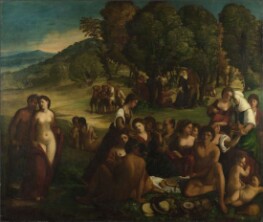Venus of Urbino
One of the greatest Renaissance paintings of a mythological nature, the life-size Venus of Urbino remains the iconic version of the reclining female nude, and a treasure of the Venetian High Renaissance. The picture was based on the earlier work The Sleeping Venus (1510) by Giorgione, a close friend of the artist, although Titian's interpretation of the goddess is much more erotic. This sensuality is heightened by the directness of the nude's gaze, her faint smile, and her awareness of the viewer, along with the depiction of her in an opulent domestic environment without the allegorical or mythological symbols traditionally associated with Venus. While Giorgione's nude is idealized and demure, Titian's is realistic and tempting. The warm, light tones of her skin are in contrast to the darker, more affluent background, and the play of light on her body and subtle use of chiaroscuro gives a sculptural quality to the nude. Her curves also contrast with the regularity of architectural elements, including the tiled floor, classical column, and green hanging, which bisects the scene, highlighting the fertile center of the figure.
Titian's exceptional talent, his bold depiction of female sensuality, and his status as the leading Venetian painter of the Cinquecento is why this picture is often cited as the origin of many of Western art's most controversial images - including, for instance, The Nude Maja (c.1797) by Goya, as well as Olympia (1863) by Edouard Manet - and is considered to be the original precursor to the pin-up.
Titian painted this picture for the Duke of Camerino Guidobaldo della Rovere, who later became the Duke of Urbino, possibly to celebrate his marriage to Giuliana Varano. Despite her erotic air, Titian's Venus is no courtesan, and the painting is not a subtle promotion of casual infidelity. On the contrary, given that it was painted to commemorate Guidobaldo's marriage, it is almost certainly celebrating marital love and the physical intimacy between man and wife, a supposition supported by a number of details. In her right hand, for instance, the girl holds a posy of roses, which usually symbolize love; also, the sleeping dog is a common symbol of fidelity; lastly, the maids in the background are depicted rummaging in a traditional cassone, where wives commonly stored their trousseaux. Perhaps the picture was conceived as an ideal model of behavior for Giuliana, the Duke's young bride. It was certainly not uncommon for pictures of an explicitly erotic nature to be commissioned to celebrate a wedding, although they would be intended for private viewing only.
The Venus of Urbino is full of artistic devices. To begin with, Titian achieves a beautiful contrast between the voluptuous curves of the girl's body and the vertical and horizontal lines of the dividing screen, floor tiles, and other architectural elements. The play of light on the girl's body and Titian's delicate chiaroscuro lends a sculptural quality to her figure and also enhances the silky drapery of the bedsheets. The floor tiles provide an extra linear perspective, while the floral patterns of the couch, cassoni, and background tapestry - in conjunction with the rich color pigments of the screen and the maid's costume - help to unify and activate the composition.
By the time he executed this work, Titian was established as the leading master of Renaissance art in Venice. Above all, he was known for his remarkable use of color, and his works - which spanned all the major genres, including church altarpieces, mythological painting, portrait art, and pastoral landscape - were increasingly sought after by members of Italian Royal Houses. He went on to become recognized as a genius in his own time and has since been revered by such Old Masters as Van Dyck, Poussin, Rubens and Velazquez. In many subjects and painting genres, he set patterns that were copied by generations of painters, especially in portraiture. Unfortunately, his talent as an artist was not matched by his generosity of spirit: he became notorious for his greed and miserliness.
















